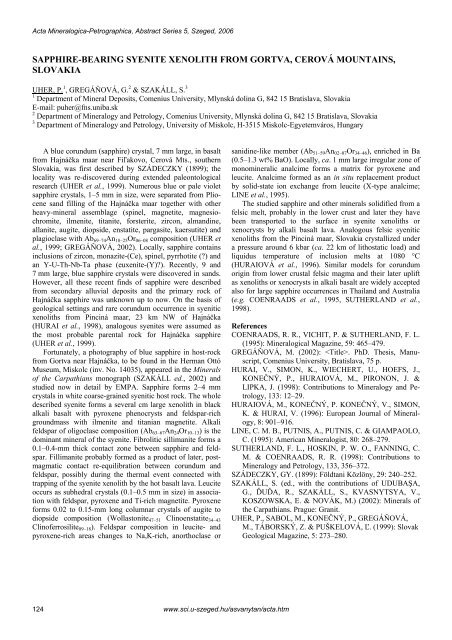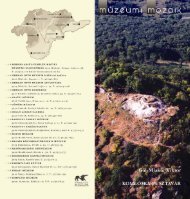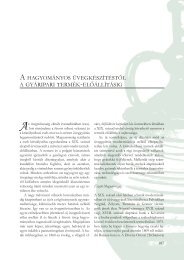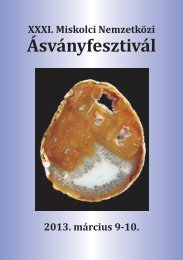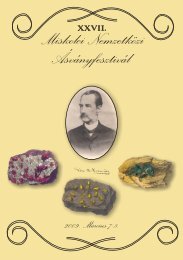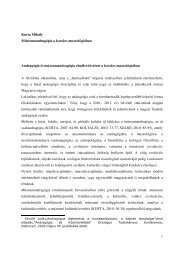Acta Mineralogica-Petrographica, Abstract Series 5, Szeged, 2006SAPPHIRE-BEAR<strong>IN</strong>G SYENITE XENOLITH FROM GORTVA, CEROVÁ MOUNTA<strong>IN</strong>S,SLOVAKIAUHER, P. 1 , GREGÁŇOVÁ, G. 2 & SZAKÁLL, S. 31 Department of Mineral Deposits, Comenius University, Mlynská dolina G, 842 15 Bratislava, SlovakiaE-mail: puher@fns.uniba.sk2 Department of Mineralogy and Petrology, Comenius University, Mlynská dolina G, 842 15 Bratislava, Slovakia3 Department of Mineralogy and Petrology, University of Miskolc, H-3515 Miskolc-Egyetemváros, HungaryA blue corundum (sapphire) crystal, 7 mm large, in basaltfrom Hajnáčka maar near Fiľakovo, Cerová Mts., southernSlovakia, was first described by SZÁDECZKY (1899); thelocality was re-discovered during extended paleontologicalresearch (UHER et al., 1999). Numerous blue or pale violetsapphire crystals, 1–5 mm in size, were separated from Pliocenesand filling of the Hajnáčka maar together with otherheavy-mineral assemblage (spinel, magnetite, magnesiochromite,ilmenite, titanite, forsterite, zircon, almandine,allanite, augite, diopside, enstatite, pargasite, kaersutite) andplagioclase with Ab 69–74 An 18–25 Or 06–08 composition (UHER etal., 1999; GREGÁŇOVÁ, 2002). Locally, sapphire containsinclusions of zircon, monazite-(Ce), spinel, pyrrhotite (?) andan Y-U-Th-Nb-Ta phase (euxenite-(Y)?). Recently, 9 and7 mm large, blue sapphire crystals were discovered in sands.However, all these recent finds of sapphire were describedfrom secondary alluvial deposits and the primary rock ofHajnáčka sapphire was unknown up to now. On the basis ofgeological settings and rare corundum occurrence in syeniticxenoliths from Pinciná maar, 23 km NW of Hajnáčka(HURAI et al., 1998), analogous syenites were assumed asthe most probable parental rock for Hajnáčka sapphire(UHER et al., 1999).Fortunately, a photography of blue sapphire in host-rockfrom Gortva near Hajnáčka, to be found in the Herman OttóMuseum, Miskolc (inv. No. 14035), appeared in the Mineralsof the Carpathians monograph (SZAKÁLL ed., 2002) andstudied now in detail by EMPA. Sapphire forms 2–4 mmcrystals in white coarse-grained syenitic host rock. The wholedescribed syenite forms a several cm large xenolith in blackalkali basalt with pyroxene phenocrysts and feldspar-richgroundmass with ilmenite and titanian magnetite. Alkalifeldspar of oligoclase composition (Ab 63–67 An 24 Or 10–13 ) is thedominant mineral of the syenite. Fibrolitic sillimanite forms a0.1–0.4-mm thick contact zone between sapphire and feldspar.Fillimanite probably formed as a product of later, postmagmaticcontact re-equilibration between corundum andfeldspar, possibly during the thermal event connected withtrapping of the syenite xenolith by the hot basalt lava. Leuciteoccurs as subhedral crystals (0.1–0.5 mm in size) in associationwith feldspar, pyroxene and Ti-rich magnetite. Pyroxeneforms 0.02 to 0.15-mm long columnar crystals of augite todiopside composition (Wollastonite 47–51 Clinoenstatite 34–43Clinoferrosilite 09–18 ). Feldspar composition in leucite- andpyroxene-rich areas changes to Na,K-rich, anorthoclase orsanidine-like member (Ab 51–59 An 02–07 Or 34–46 ), enriched in Ba(0.5–1.3 wt% BaO). Locally, ca. 1 mm large irregular zone ofmonomineralic analcime forms a matrix for pyroxene andleucite. Analcime formed as an in situ replacement productby solid-state ion exchange from leucite (X-type analcime;L<strong>IN</strong>E et al., 1995).The studied sapphire and other minerals solidified from afelsic melt, probably in the lower crust and later they havebeen transported to the surface in syenite xenoliths orxenocrysts by alkali basalt lava. Analogous felsic syeniticxenoliths from the Pinciná maar, Slovakia crystallized undera pressure around 6 kbar (ca. 22 km of lithostatic load) andliquidus temperature of inclusion melts at 1080 °C(HURAIOVÁ et al., 1996). Similar models for corundumorigin from lower crustal felsic magma and their later upliftas xenoliths or xenocrysts in alkali basalt are widely acceptedalso for large sapphire occurrences in Thailand and Australia(e.g. COENRAADS et al., 1995, SU<strong>THE</strong>RLAND et al.,1998).ReferencesCOENRAADS, R. R., VICHIT, P. & SU<strong>THE</strong>RLAND, F. L.(1995): Mineralogical Magazine, 59: 465–479.GREGÁŇOVÁ, M. (2002): . PhD. Thesis, Manuscript,Comenius University, Bratislava, 75 p.HURAI, V., SIMON, K., WIECHERT, U., HOEFS, J.,KONEČNÝ, P., HURAIOVÁ, M., PIRONON, J. &LIPKA, J. (1998): Contributions to Mineralogy and Petrology,133: 12–29.HURAIOVÁ, M., KONEČNÝ, P. KONEČNÝ, V., SIMON,K. & HURAI, V. (1996): European Journal of Mineralogy,8: 901–916.L<strong>IN</strong>E, C. M. B., PUTNIS, A., PUTNIS, C. & GIAMPAOLO,C. (1995): American Mineralogist, 80: 268–279.SU<strong>THE</strong>RLAND, F. L., HOSK<strong>IN</strong>, P. W. O., FANN<strong>IN</strong>G, C.M. & COENRAADS, R. R. (1998): Contributions toMineralogy and Petrology, 133, 356–372.SZÁDECZKY, GY. (1899): Földtani Közlöny, 29: 240–252.SZAKÁLL, S. (ed., with the contributions of UDUBAŞA,G., ĎUĎA, R., SZAKÁLL, S., KVASNYTSYA, V.,KOSZOWSKA, E. & NOVÁK, M.) (2002): Minerals ofthe Carpathians. Prague: Granit.UHER, P., SABOL, M., KONEČNÝ, P., GREGÁŇOVÁ,M., TÁBORSKÝ, Z. & PUŠKELOVÁ, Ľ. (1999): SlovakGeological Magazine, 5: 273–280.124www.sci.u-szeged.hu/asvanytan/acta.htm
Acta Mineralogica-Petrographica, Abstract Series 5, Szeged, 2006COMPOSITIONAL VARIATIONS OF PEGMATITE Nb-Ta <strong>M<strong>IN</strong>ERAL</strong> ASSEMBLAGE FROM<strong>THE</strong> LIMBACH AREA, MALÉ KARPATY MTS., SLOVAKIAUHER, P. 1 , ŽITŇAN, P. 2 & OZDÍN, D. 21 Department of Mineral Deposits, Comenius University; Mlynská dolina G, 842 15 Bratislava, SlovakiaE-mail: puher@fns.uniba.sk2 Department of Mineralogy and Petrology, Comenius University; Mlynská dolina G, 842 15 Bratislava, SlovakiaA varied association of Nb-Ta oxide minerals was discoveredduring heavy-mineral prospecting in Limbach brook,NW of Pezinok, SW Slovakia. Besides of common heavyminerals (garnet, staurolite, zircon, apatite, monazite-(Ce),ilmenite, magnetite, gold), members of the columbite–tantalite (Ct) group, ferrotapiolite, Sn-rich ixiolite, Ta-richrutile and microlite to uranmicrolite were identified togetherwith uraninite and Hf-rich zircon (11-15 wt% HfO 2 , 0.11-0.14 Hf apfu). The textural and compositional relations aswell as local geological setting indicate a granitic pegmatiteorigin of the heavy mineral Nb-Ta assemblage. The surroundingrocks are Hercynian leucogranites of the Bratislava Massif(the Staré Mesto body) and Lower Paleozoic micaschiststo paragneisses. Numerous pegmatite veins cut both the parentalgranites as well as the metapelites-metapsammites.Minerals of the Ct group are the most widespread Nb-Taphases. Five basic textural and compositional types of Ctminerals could be distinguished:(Ct1) Large crystals (up to 4 mm) with regular fine tocoarse oscillatory zoning, locally unzoned or with diffusezonality. They belong to ferrocolumbite, rarely ferrotantalite,manganocolumbite and manganotantalite with broad compositionalvariations: (atomic ratio:) Mn/(Mn + Fe) = 0.17–0.52and Ta/(Ta + Nb) = 0.19–0.70.(Ct2) Irregular patchy intergrowths of ferrocolumbite –ferrotantalite with Ta-rich rutile (ca. 1 mm in size); Mn/(Mn+ Fe) = 0.19–0.27 and Ta/(Ta + Nb) = 0.49–0.57. Ct showsincreased Ti and W contents (up to 2.3 wt% TiO 2 and0.7 wt% WO 3 ).(Ct3) Irregular patchy intergrowths of ferrotantalite–manganotantalite with ferrotapiolite (ca. 0.6 mm in size);Mn/(Mn + Fe) = 0.34–0.66 and Ta/(Ta + Nb) = 0.65–0.81.(Ct4) Irregular bended zones of ferrocolumbite (up to0.3 mm long) with fine oscillatory zoning which replace Ct1.The zoning is caused by Nb-Ta variation with increasing ofTa/Nb ratio; Mn/(Mn + Fe) = 0.16–0.19 and Ta/(Ta + Nb) =0.16–0.34.(Ct5) Irregular patchy zones of ferrocolumbite to ferrotantalite(0.2–0.9 mm) along cracks and rims of Ct1; Mn/(Mn +Fe) = 0.43–0.49 and Ta/(Ta + Nb) = 0.24–0.61.The Ct1 belongs to primary magmatic minerals, whereasCt2 and Ct3 are probably products of sub-solidus (?) recrystallizationof primary phases and textural patterns of Ct4 andCt5 indicate late- to post-magmatic replacement of Ct1.Compositional evolution of Ct is complex without unambiguousfractionation trend.Ferrotapiolite forms anhedral intergrowths in Ct3 or inclusionsin Ct1, 60 to 100 µm in size; Mn/(Mn + Fe) = 0.05–0.07, Ta/(Ta + Nb) = 0.87–0.93. Rarely, a Sn-rich ixiolitelikephase with Mn/(Mn + Fe) = 0.40 and Ta/(Ta + Nb) =0.81 and 9.4 wt% SnO 2 occurs as 110 µm irregular inclusionin Ct1. Ta-rich rutile (strüverite) shows relatively uniformcompositions with Mn/(Mn + Fe) = 0.01–0.03 and Ta/(Ta +Nb) = 0.80–0.84. Rare microlite to uranmicrolite forms anhedral,5–15 µm thick overgrowth on uraninite in partly recrystallizedpart of Ct1; Ta/(Ta + Nb) = 0.82–0.94, U = 16–47 atom % of A site.The above mentioned Nb-Ta association from Limbacharea with variable but relatively high Ta/Nb and Mn/Fe ratiosindicates a moderate fractionation level, typical for the rareelementclass of granitic pegmatites of LCT family, probablyberyl-columbite subtype (sensu ČERNÝ, 1991). Such pegmatiteswith beryl, columbite–tantalite, Hf-rich zircon, gahniteand almandine–spessartine are typical of the surroundingBratislava S-type granitic massif (UHER et al., 1994, UHER& ČERNÝ, 1998).ReferencesČERNÝ, P. (1991): Geoscience Canada, 18: 29–41.UHER, P. & ČERNÝ, P. (1998): Geologica Carpathica, 49:261–270.UHER, P., ČERNÝ, P., NOVÁK, M. & SIMAN, P. (1994):Mineralia Slovaca, 26: 157–164.www.sci.u-szeged.hu/asvanytan/acta.htm 125
- Page 1:
MSCC33 rd MINERAL SCIENCES IN THE C
- Page 5 and 6:
Acta Mineralogica-Petrographica, Ab
- Page 7 and 8:
Acta Mineralogica-Petrographica, Ab
- Page 9 and 10:
Acta Mineralogica-Petrographica, Ab
- Page 11 and 12:
Acta Mineralogica-Petrographica, Ab
- Page 13 and 14:
Acta Mineralogica-Petrographica, Ab
- Page 15 and 16:
Acta Mineralogica-Petrographica, Ab
- Page 17 and 18:
Acta Mineralogica-Petrographica, Ab
- Page 19 and 20:
Acta Mineralogica-Petrographica, Ab
- Page 21 and 22:
Acta Mineralogica-Petrographica, Ab
- Page 23 and 24:
Acta Mineralogica-Petrographica, Ab
- Page 25 and 26:
Acta Mineralogica-Petrographica, Ab
- Page 27 and 28:
Acta Mineralogica-Petrographica, Ab
- Page 29 and 30:
Acta Mineralogica-Petrographica, Ab
- Page 31 and 32:
Acta Mineralogica-Petrographica, Ab
- Page 33 and 34:
Acta Mineralogica-Petrographica, Ab
- Page 35 and 36:
Acta Mineralogica-Petrographica, Ab
- Page 37 and 38:
Acta Mineralogica-Petrographica, Ab
- Page 39 and 40:
Acta Mineralogica-Petrographica, Ab
- Page 41 and 42:
Acta Mineralogica-Petrographica, Ab
- Page 43 and 44:
Acta Mineralogica-Petrographica, Ab
- Page 45 and 46:
Acta Mineralogica-Petrographica, Ab
- Page 47 and 48:
Acta Mineralogica-Petrographica, Ab
- Page 49 and 50:
Acta Mineralogica-Petrographica, Ab
- Page 51 and 52:
Acta Mineralogica-Petrographica, Ab
- Page 53 and 54:
Acta Mineralogica-Petrographica, Ab
- Page 55 and 56:
Acta Mineralogica-Petrographica, Ab
- Page 57 and 58:
Acta Mineralogica-Petrographica, Ab
- Page 59 and 60:
Acta Mineralogica-Petrographica, Ab
- Page 61 and 62:
Acta Mineralogica-Petrographica, Ab
- Page 63 and 64:
Acta Mineralogica-Petrographica, Ab
- Page 65 and 66:
Acta Mineralogica-Petrographica, Ab
- Page 67 and 68:
Acta Mineralogica-Petrographica, Ab
- Page 69 and 70:
Acta Mineralogica-Petrographica, Ab
- Page 71 and 72:
Acta Mineralogica-Petrographica, Ab
- Page 73 and 74: Acta Mineralogica-Petrographica, Ab
- Page 75 and 76: Acta Mineralogica-Petrographica, Ab
- Page 77 and 78: Acta Mineralogica-Petrographica, Ab
- Page 79 and 80: Acta Mineralogica-Petrographica, Ab
- Page 81 and 82: Acta Mineralogica-Petrographica, Ab
- Page 83 and 84: Acta Mineralogica-Petrographica, Ab
- Page 85 and 86: Acta Mineralogica-Petrographica, Ab
- Page 87 and 88: Acta Mineralogica-Petrographica, Ab
- Page 89 and 90: Acta Mineralogica-Petrographica, Ab
- Page 91 and 92: Acta Mineralogica-Petrographica, Ab
- Page 93 and 94: Acta Mineralogica-Petrographica, Ab
- Page 95 and 96: Acta Mineralogica-Petrographica, Ab
- Page 97 and 98: Acta Mineralogica-Petrographica, Ab
- Page 99 and 100: Acta Mineralogica-Petrographica, Ab
- Page 101 and 102: Acta Mineralogica-Petrographica, Ab
- Page 103 and 104: Acta Mineralogica-Petrographica, Ab
- Page 105 and 106: Acta Mineralogica-Petrographica, Ab
- Page 107 and 108: Acta Mineralogica-Petrographica, Ab
- Page 109 and 110: Acta Mineralogica-Petrographica, Ab
- Page 111 and 112: Acta Mineralogica-Petrographica, Ab
- Page 113 and 114: Acta Mineralogica-Petrographica, Ab
- Page 115 and 116: Acta Mineralogica-Petrographica, Ab
- Page 117 and 118: Acta Mineralogica-Petrographica, Ab
- Page 119 and 120: Acta Mineralogica-Petrographica, Ab
- Page 121 and 122: Acta Mineralogica-Petrographica, Ab
- Page 123: Acta Mineralogica-Petrographica, Ab
- Page 127 and 128: Acta Mineralogica-Petrographica, Ab
- Page 129 and 130: Acta Mineralogica-Petrographica, Ab
- Page 131 and 132: Acta Mineralogica-Petrographica, Ab
- Page 133 and 134: Acta Mineralogica-Petrographica, Ab


